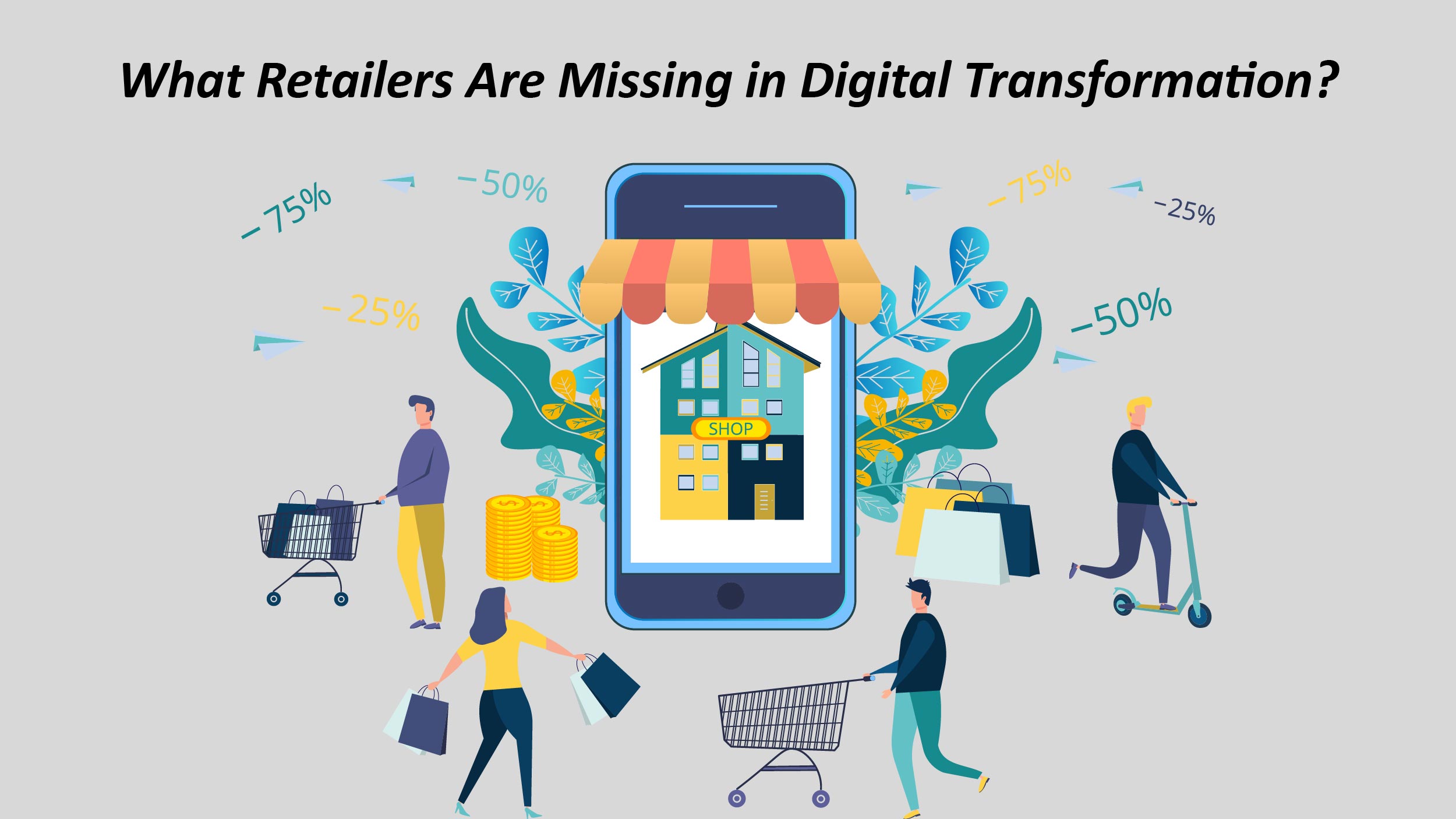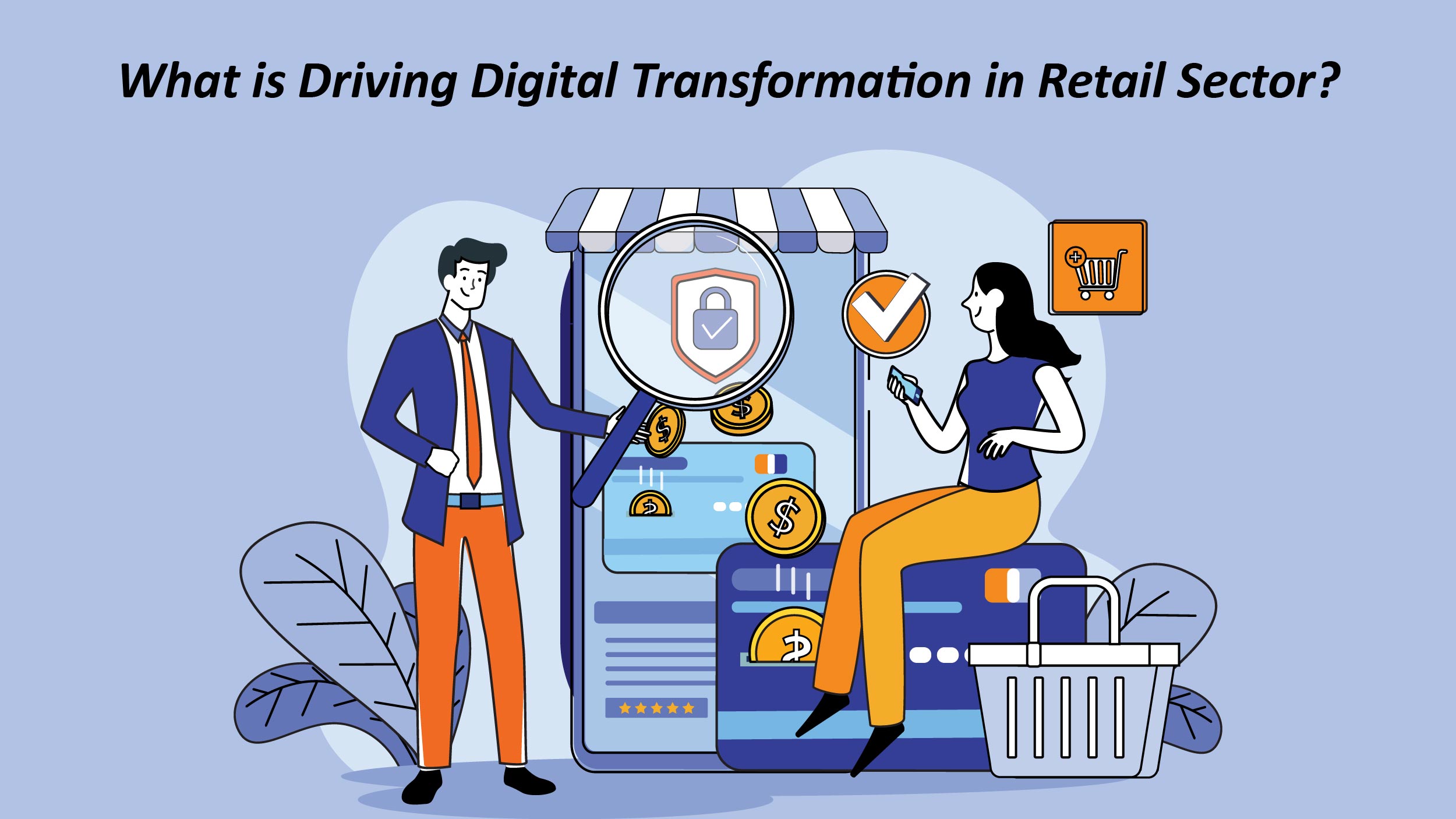A large 93% of shopping journeys now start online, according to Microsoft. This digital change shows a big challenge for traditional stores: how to link the ease of online shopping and the in-person experience customers still want.
Digital transformation in retail isn’t just a trend; it’s the way to unlock a future where physical and digital experiences work well together. This will let stores not just survive, but thrive in this changing world. This article walks you through exactly this concept.
What does Digital Transformation in Retail Mean?
Retail digital transformation uses technology to improve how retail businesses work. This includes things like point-of-sale systems, personalized shopping, self-checkout, cost savings, virtual reality showrooms, mobile apps, location tracking, and AI product suggestions. These changes help retail businesses operate more efficiently, give customers a better experience, and grow their business.
Retail automation and digital transformation in retail are revolutionizing the way businesses operate, leading to improved efficiency, enhanced customer experiences, and increased competitiveness in the market.
What Retailers Are Missing in Digital Transformation?

Provide More Personalized CX Than Their Competitors
As stores closed during the pandemic, online shopping grew. People still wanted to shop while at home, using their phones. This made the customer experience (CX) very important. A poor experience would likely drive customers away. Retailers have learned that delivering an excellent customer experience is key to building brand loyalty.
But that’s the basic level of service. Customers want personalized service from the companies they shop with. They’re okay with sharing their data if it means you’ll give them that. Retailers must therefore develop individualized, customized discussions at scale for all service channels.
Create Personal Conversations With Humans and Automation
Customers want to connect with their favorite brands. One way to create good experiences is to be where customers want to talk to you. They may have simple questions that a chatbot can easily answer. This keeps customers happy and frees up your team to handle more complex queries. If you’re not using chat, you’re falling behind.
Leverage Customer Service
Your customer service agents interact with customers the most. They know what customers ask about, what problems they have with your products, and when they’re likely to contact you. Each interaction is a chance to do more than just solve customer issues. You can also create profit.
Retailers can make customer service a profit center by being proactive. Integrating marketing, e-commerce, and support software helps agents make personalized recommendations.
For example, if a customer wants to return something, agents can see past purchases and size preferences. Then they can suggest a different product the customer might like. This chance to sell more products can earn more money and make customers happy.
What is Driving Digital Transformation in Retail Sector?

The retail industry is a massive global market worth $9.93 trillion by 2030. It employs over 1.8 billion people. There are also 2.64 billion online shoppers worldwide. Retailers can no longer rely only on low prices, convenient locations, and product variety to create value and build loyalty. The one-size-fits-all approach to communications and promotions is outdated. Retailers now need to personalize their communications and marketing tactics to keep existing customers and attract new ones.
Retailers can now use data to understand their customers better. They can use this information to get existing customers to shop more often. They can also find and target high-value customers from traditional retailers.
The demand for digital changes in retail has grown. This is because digital changes can directly increase sales and growth for retailers.
Challenges Faced by Digital Transformation in Retail
Digital transformation in retail poses significant challenges owing to the complexity of the involved technology and the imperative for organizations to adapt their existing processes and systems. Moreover the integration of digital transformation into your business introduces security concerns that demand attention.
Less Qualified Experts
Digital transformation within the retail sector presents a specific challenge concerning the lack of skilled professionals. This challenge arises due to the need for specialized proficiencies such as software engineering, data analytics, AI, cloud computing, mobile development, and cybersecurity expertise. These competencies are not always readily available within an organization, necessitating the utilization of external experience.
Cost of Transformation
Handling financial issues turns out to be a major puzzle. These projects require large initial outlays before any indications of profitability appear. Businesses must also decide whether to develop project pieces internally using their own resources or farm them out to third parties. There are benefits and cons to both options, depending on the particular needs of each company.
Security Concerns
Security risks loom large demanding vigilant protection of customer data while facilitating essential corporate access for marketing and operational efficiencies. It is essential to make significant investments in authentication systems, encryption techniques, and frequent system audits to adhere to industry standards such as PCI DSS (Payment Card Industry Data Security Standard). To bolster their defenses they should also contemplate integrating two-factor authentication and intrusion detection systems.
Also Read: E-commerce Trends You Need to Know to Upscale Your Business
Discover the latest trends shaping the digital landscape of retail in 2024.
Big Data
Retailers are tapping into the vast reservoir of big data to gain deeper insights into their customer base. Today’s consumers crave personalized and efficient shopping experiences, and retailers are meeting this demand by leveraging predictive and prescriptive analytics. These insights enable retailers to optimize inventory management, refine merchandising strategies, and develop more effective procurement plans. By making data-informed decisions, retailers can enhance their return on investment while delivering tailored experiences to their customers.
Omnichannel Retailing
In an increasingly interconnected world, customers who engage across both physical and digital retail platforms are proving to be invaluable to retailers. Omnichannel retailing involves seamlessly integrating business transactions across various channels, such as social media, email, and websites. By adopting an omnichannel approach, retailers can create a cohesive and frictionless shopping journey for their customers. Noteworthy examples include Home Depot, which has curated personalized shopping experiences through features like click-and-collect services and targeted marketing initiatives.
Internet of Things (IoT)
The advent of IoT technology is revolutionizing how retailers track products throughout the supply chain. Utilizing GPS and RFID technology, retailers can accurately monitor the movement of goods, leading to enhanced operational efficiency and inventory management. Moreover, IoT innovations have empowered retailers to combat shoplifting through techniques like geofencing. With over $25 million worth of merchandise being stolen from retail stores daily, RFID tags enable retailers to establish virtual boundaries around their premises, effectively deterring theft and safeguarding their assets.
Benefits of Digital Transformation in Retail
- Enhanced Customer Retention: Retailers can boost customer loyalty by tailoring personalized communications and promotions based on customer segmentation and purchasing behavior. For instance, a fitness enthusiast who regularly buys health supplements could receive targeted promotions, fostering increased purchase frequency and retention.
- Valuable Market Insights: Analyzing consumer data yields invaluable market insights, empowering retailers to devise strategies for sustainable growth and profitability. These insights deepen retailers’ understanding of their customer base, fostering a heightened sense of intimacy and driving business growth.
- Efficient Marketing Campaigns: Digital transformation enables retailers to harness customer data to create personalized, targeted marketing campaigns using tools such as CRM, data analytics, and marketing automation. This data-driven approach identifies consumer patterns and trends, optimizing marketing efforts while reducing the costs associated with traditional marketing activities.
- Streamlined Inventory Management: Technology-driven inventory management enhances operational efficiency, enabling retailers to automate processes and ensure timely order fulfillment. Digital transformation facilitates effective warehouse management, lead time calculation, and safety stock optimization, minimizing stock-outs and maximizing inventory utilization.
- Enhanced Customer Service: By embracing digital technologies, retailers can provide omnichannel customer support across multiple platforms, including websites, mobile apps, and live chat. Self-service options such as chatbots enable round-the-clock personalized assistance, facilitating seamless customer journeys and cost-efficient service delivery.
End Note
With consumers increasingly choosing to shop and make other purchases online, digital transformation in retail is becoming more important to stay relevant. Retailers that continue to use outdated strategies run the risk of losing business to Internet and data-driven companies. Hence, retailers need to keep up with the latest trends and technology to set up their organizations for success and expansion.



